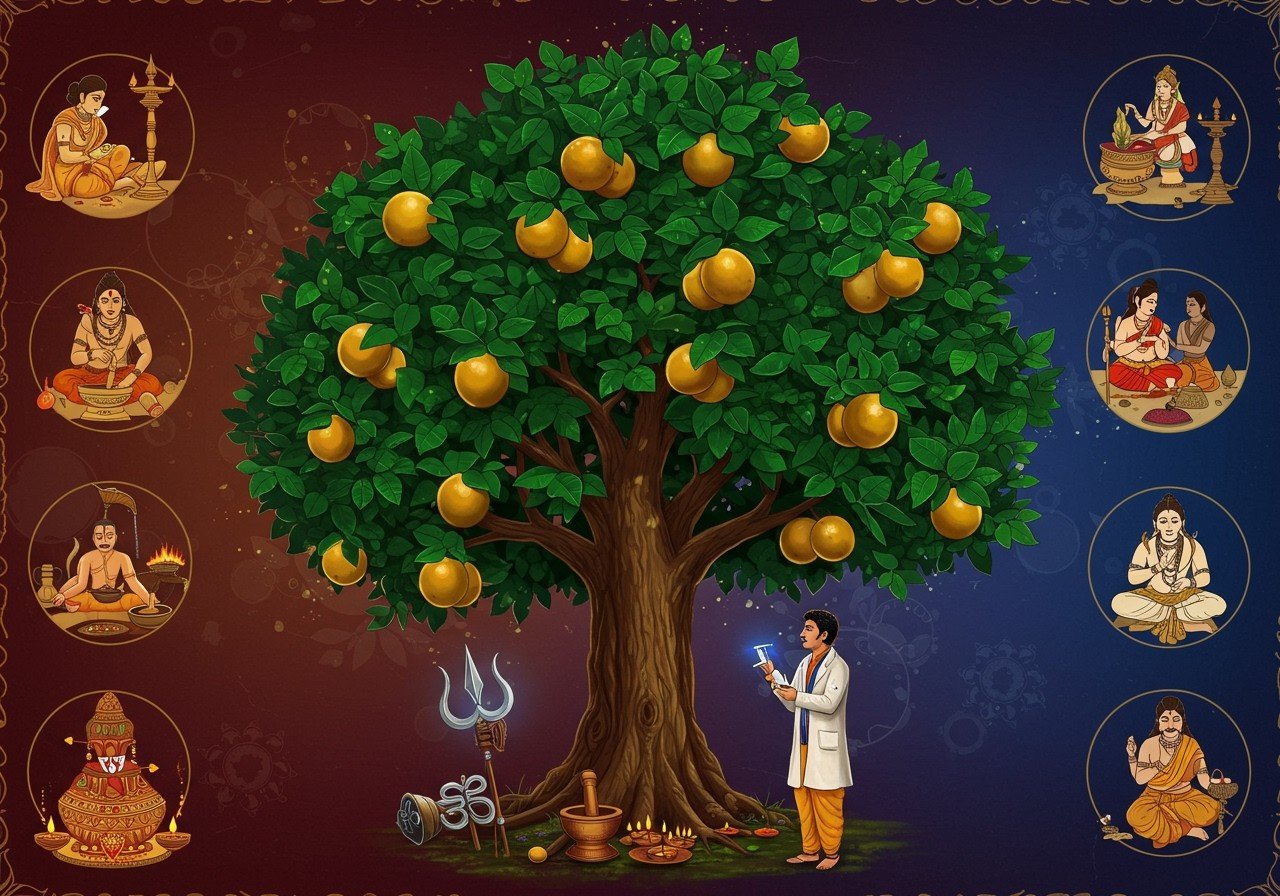
In the heart of Indian tradition, the Bael tree (Aegle Marmelos) holds a revered place. From its fragrant flowers offered in prayer to its nourishing fruit used for both health and spiritual practices, this tree is deeply intertwined with our culture. Let’s explore the unique qualities of this sacred tree and its continued relevance in our modern lives.
Exploring the Bael Tree’s Lineage and Blossom
The Bael tree belongs to the Rutaceae family, known for its aromatic leaves and citrus fruits. This family encompasses a diverse range of plants vital to various ecosystems. The Bael tree stands out with its unique traits, having adapted remarkably well to the varied climates across India. Research continually reveals its remarkable genetic diversity, highlighting its ecological importance and adaptability.
The Bael flower, delicate and fragrant, blooms once a year, marking a special time in many Indian households. Often offered to Lord Shiva, it symbolizes purity and devotion, adding a spiritual depth to rituals. Beyond their beauty, these blossoms play a vital role in the tree’s life cycle, attracting pollinators like bees, ensuring the continuation of its lineage. The timing of these blooms is intricately linked to seasonal changes, influencing the development of the cherished Bael fruit.
A Closer Look at the Bael Tree
The Bael tree, with its sturdy trunk and thorny branches, can grow to impressive heights. Its aromatic leaves and deeply rooted system reflect its strength and resilience. Adaptable to various soil conditions, it thrives particularly well in well-drained environments, demonstrating a hardiness fostered by India’s diverse climatic regions. Traditional cultivation methods have long nurtured its growth, and modern techniques are now being employed to further enhance its fruit yield and growth rate. A natural resistance to pests makes it an environmentally friendly choice, requiring minimal chemical intervention. Furthermore, the Bael tree contributes positively to the ecosystem by aiding in soil stabilization and carbon sequestration.
Bael Fruit: A Bounty of Benefits in 2025
The Bael fruit continues to be cherished for its numerous health advantages. Rich in fiber, it’s a boon for digestive health, helping to regulate bowel movements and alleviate issues like constipation and IBS. The fruit’s abundance of Vitamin C and antioxidants bolsters the immune system, assisting in the fight against infections and helping with detoxification. Bael leaves, rich in flavonoids and polyphenols, contribute to blood sugar balance, a benefit particularly valuable for those managing type 2 diabetes. The high potassium content in Bael fruit also supports heart health by promoting healthy blood pressure and enhancing arterial function.
In today’s world, the Bael fruit’s properties are embraced in diverse ways. You can enjoy its refreshing coolness in a traditional Bel Sherbet, a perfect antidote to the summer heat. Alternatively, dry Bael slices can be steeped in hot water for a calming herbal tea. Its pulp can be incorporated into smoothies, chutneys, or even desserts, adding a unique flavor profile. Beyond culinary uses, Bael finds its place in modern wellness trends, included in dietary supplements and skincare products due to its anti-inflammatory and detoxifying effects. Research is ongoing to further understand its therapeutic potential, ensuring its continued importance in both traditional and contemporary health practices.
At poojn.in, we understand the significance of this sacred fruit and offer a range of products to help you incorporate its goodness into your life. Explore our selection of Bael products.
Cultural Reverence for the Bael Tree
Deeply embedded in Indian culture, the Bael tree holds profound religious and spiritual significance. In Hindu mythology, it is closely associated with Lord Shiva and plays a vital role in festivals and rituals. Offering Bael leaves to Lord Shiva is a common practice across various regions and communities, each holding unique interpretations of the tree’s symbolism. In literature and art, the Bael tree represents continuity and devotion, its presence a reminder of our rich cultural heritage. Planting a Bael tree is seen as an act of both honoring tradition and fostering biodiversity, connecting ancient wisdom with a sustainable future.
Find authentic Bael leaves and other puja essentials at poojn.in. We offer a wide variety of holy idols , jewelry, utensils, herbs & cosmetics for your spiritual needs.
The Bael Tree’s Enduring Legacy
As we move forward, the Bael tree continues to stand as a symbol of the harmonious blend of tradition and modernity. It enriches our cultural and spiritual lives while offering health benefits that resonate with modern wellness aspirations. Whether used in sacred rituals or as a part of modern wellness practices, the Bael tree holds an undeniable place in our lives. By embracing it, we celebrate the wisdom of our ancestors while contributing to a sustainable world.
Common Questions About the Bael Tree
What family does the Bael tree belong to? The Bael tree (Aegle marmelos) is a member of the Rutaceae family, known for citrus fruits and aromatic plants, including important species within various ecosystems. The Bael tree itself displays a unique genetic diversity and adaptability.
What distinguishes Aegle Marmelos flowers? Aegle Marmelos flowers are delicate and fragrant, blooming once a year in greenish-white clusters. They are significant in rituals and attract pollinators, playing a vital role in the tree’s lifecycle. The timing of their appearance is influenced by seasonal variations.
How would you describe the Aegle Marmelos tree? The Aegle Marmelos tree is a medium-sized deciduous tree, characterized by a thick trunk, thorny branches, and oval-shaped leaves. It’s known for its adaptable nature, thriving in varied climates and soil conditions across India. It also bears a hard-shelled fruit rich in health benefits.
What are the traditional uses of the Bael tree? Deeply rooted in tradition, the Bael tree has a long history of use in Ayurvedic medicine. Its leaves, fruit, and bark are believed to have medicinal properties, especially for digestive health and respiratory ailments. Various parts of the tree are used in traditional remedies for several health concerns.
Can I grow a Bael tree in a city? Yes, the Bael tree’s adaptability makes it suitable for urban environments. It tolerates various soil types and drier conditions, making it a good choice for city gardens or other urban green spaces. Its resilience allows it to thrive even in less-than-ideal conditions.
Why is the Bael tree important in Indian culture? The Bael tree holds deep religious and cultural meaning in India. Its leaves are traditionally offered to Lord Shiva in rituals, symbolizing purity and devotion. Its presence in mythology and art further underscores its significance in our cultural heritage, fostering a connection to ancient wisdom and spiritual practices.
How do I care for a Bael tree? Bael tree care involves providing adequate sunlight, well-drained soil, and occasional watering. Regular pruning can help maintain its shape and promote healthy growth, ensuring it continues to thrive and provide its valuable fruits and leaves.


